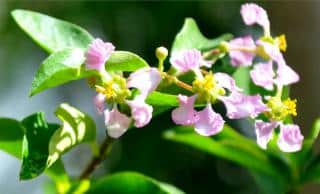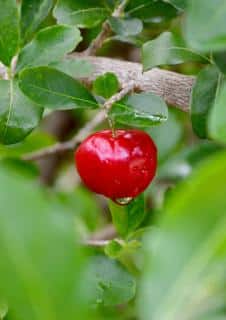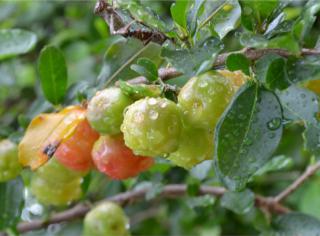

Acerola, also called Barbados cherry, is a red-colored fruit renowned and appreciated for its high levels of vitamin C.
Essential Acerola facts
Name – Acerola, Malpighia glabra
Family – Malpighiaceae
Type – fruit shrub
Height – 16 to 26 feet (5 to 8 meters) in its native setting
Exposure – sun
Soil – well-drained
Foliage – evergreen – Flowering – 6 to 7 times a year
Most often we come along it in a gelcap or tab in a pharmacy, but it actually is a slightly tangy fruit with juicy flesh.
 Native to Mexico and South America, the acerola tree is a typical tropical tree. It’s impossible to grow outdoors in temperate climates. The only option is to grown it in pots and bring it indoors in a heated moist greenhouse during winter.
Native to Mexico and South America, the acerola tree is a typical tropical tree. It’s impossible to grow outdoors in temperate climates. The only option is to grown it in pots and bring it indoors in a heated moist greenhouse during winter.
Fruit formation is also difficult to obtain when not in its natural environment. It still has great ornamental and decorative value, though.
Choose an adequate soil mix for growing an acerola tree. Typically, well-draining Mediterranean-like soil is fine. Any soil or substrate recommended for citrus plants will do equally well.
 The pot must have a hole at the bottom. Ensure there’s a drainage layer of gravel or clay beads. It’s important to let water drain away very easily.
The pot must have a hole at the bottom. Ensure there’s a drainage layer of gravel or clay beads. It’s important to let water drain away very easily.
 Many therapeutic effects are attributed to acerola, especially thanks to its high vitamin C content. Vitamin C levels are roughly 20 times higher than oranges.
Many therapeutic effects are attributed to acerola, especially thanks to its high vitamin C content. Vitamin C levels are roughly 20 times higher than oranges.
Acerola is both a tonic and a restructuring agent for our bodies. It increases muscle tone and overall vigor of our body.
Other vitamins present include vitamins B6, B1 and A. Each of these take part in protecting our health and reinforce our body’s immune system.
You can eat Acerola either directly as a fruit, or swallow it as a gelcap or tab.
If you’re hoping to produce your own acerola yourself, you’ll need an adequate space that matches its needs.